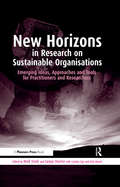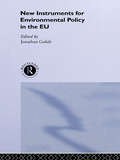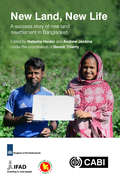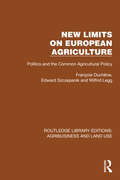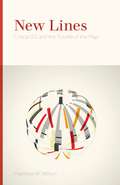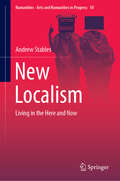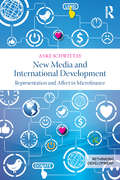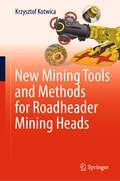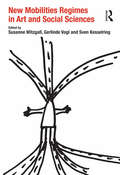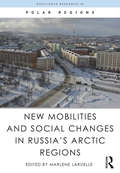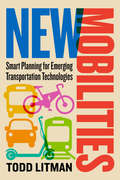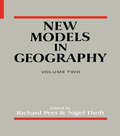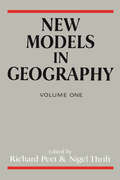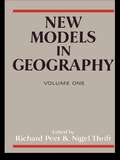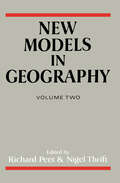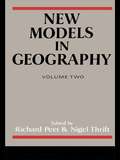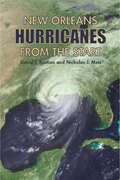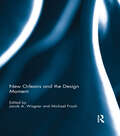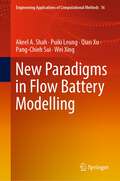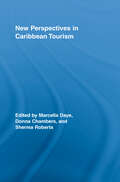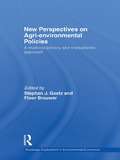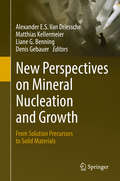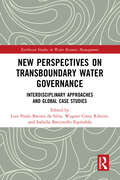- Table View
- List View
New Horizons in Research on Sustainable Organisations: Emerging Ideas, Approaches and Tools for Practitioners and Researchers
by Sanjay Sharma Mark Starik Carolyn Egri Rick BunchEnvironmental sustainability practice and research have advanced over the past decade from novelty to near-mainstream status today. During this environmentally critical time period, sustainability practitioner techniques, such as environmental, energy and social auditing, other sustainability information and related systems, and a wide variety of environmental sustainability approaches have been developed, improved and institutionalised, advancing both the practice and research of environmental sustainability management and policy. However, academics and practitioners in the sustainability field still have widely differing perspectives on what a sustainable organisation is or might be, but seldom take the opportunity to share these respective sustainability visions, let alone the multiple ways to achieve them. New Horizons in Research on Sustainable Organisations is intended to bridge this gap between academics and practitioners with cutting-edge research from both groups on progress towards sustainability. After working on sustainability-related projects involving other academics, both research- and practitioner-oriented graduate students, consultants, managers and activists, the lead co-editors of this volume saw the need to encourage information exchanges among differing networks of sustainability stakeholders to create a pathway for researchers and practitioners in the general area of organisations and the natural environment to address issues of common interest. There are many networks in the general subject area, but the cross-pollination of ideas between academics and practitioners remains sketchy. New Horizons in Research on Sustainable Organisations is intended to present and encourage such cross-pollination. The chapters in this volume are presented in three subsets, generally proceeding from the most "macro" to the most "micro" in terms of perspective and applicability. However, this arbitrary division belies the integration from macro through meso (or mid-range) to micro levels that is apparent in these studies. Macro approaches typically include wider geographic scopes, greater numbers of stakeholders, and more complex explanatory factors than micro approaches. Each chapter adopts one or more particular sustainability world-view and then grounds these and the other chapter elements within actual organisations. Therefore, the reader is advised to envision not a one-dimensional continuum but rather a circle in which the macro view both feeds back and feeds forward to the micro view. This volume addresses a number of intriguing and important sustainable organisation phenomena such as multiple sustainable development perspectives, changing environmental politics, environmental management systems variations, voluntary environmental programme performance, complex adaptive systems, and environmental technology development. Additionally, several models are suggested, such as cultivation, capabilities and business ecology frameworks.
New Instruments for Environmental Policy in the EU (Routledge/eui Studies In Environmental Policy Ser.)
by Jonathan GolubNew Instruments for Environmental Policy in the EU provides a comprehensive analysis of the debate over new forms of environmental regulation in the European Union.The conclusions draw attention to critical aspects of instrument design, as well as the difficulty of accommodating national policy diversity without contravening EU and international tr
New Itinerant Electron Models of Magnetic Materials
by Gui-De TangThis book highlights a series of new itinerant electron models proposed based on the experimental results of electron spectra obtained since 1970. Although conventional magnetic ordering models were established before 1960, many problems remain to be solved. The new models in this book include an O 2p itinerant electron model for magnetic oxides, a new itinerant electron model for magnetic metals, and a Weiss electron pair model for the origin of magnetic ordering energy of magnetic metals and oxides. With these models, the book explains typical magnetic ordering phenomena including those that cannot be explained using conventional models. These new models are easier to understand than the conventional magnetic ordering models.
New Land, New Life: A success story of new land resettlement in Bangladesh
by Md. Rezaul Karim Mihir Kumar Chakraborty Bazlul Karim Kiran Sankar Sarker Md. Robiul Islam Nujulee Begum Edward Mallorie Koen De WildeThe Ganges-Brahmaputra-Meghna delta has newly emerged 'char' islands, resulting from the deposition of sediment, which are very vulnerable, socially, institutionally and environmentally. This book explains how the governments of Bangladesh and the Netherlands and the International Fund for Agricultural Development cooperated on a land-based rural development project to give settlers security and purpose. It details how they engaged communities and civil societies, and implemented an infrastructure aimed at reducing flooding, improving drainage, and providing adequate drinking water and sanitation. The book describes the project's application to crop and animal agriculture, and the development of value chains and encouragement of female participation. It considers the financial underpinning and infrastructure, as well as how to ensure the impacts of the scheme are enduring. The scheme serves as a model for support projects to vulnerable groups faced with climate change and other environmental challenges. This book is suitable for students, researchers, specialists and practitioners in rural development, water resources, land management and soil science.
New Limits on European Agriculture: Politics and the Common Agricultural Policy (Routledge Library Editions: Agribusiness and Land Use #7)
by François Duchêne Edward Szczepanik Wilfrid LeggUntil about 1970, Western Europe was regarded as the great food-importing region of the world. Over the next 15 years it also became a major food exporter. This study, originally published in 1985, analyses the expansionary policies of individual nations, as well as those of the Community itself, which have helped produce this momentous reversal of Western Europe’s traditional role. The phenomenon in the international food market is reviewed within the context of the economic and political forces responsible for changes in Western European agriculture during the late 20th Century.
New Lines: Critical GIS and the Trouble of the Map
by Matthew W. WilsonNew Lines takes the pulse of a society increasingly drawn to the power of the digital map, examining the conceptual and technical developments of the field of geographic information science as this work is refracted through a pervasive digital culture. Matthew W. Wilson draws together archival research on the birth of the digital map with a reconsideration of the critical turn in mapping and cartographic thought. Seeking to bridge a foundational divide within the discipline of geography—between cultural and human geographers and practitioners of Geographic Information Systems (GIS)—Wilson suggests that GIS practitioners may operate within a critical vacuum and may not fully contend with their placement within broader networks, the politics of mapping, the rise of the digital humanities, the activist possibilities of appropriating GIS technologies, and more.Employing the concept of the drawn and traced line, Wilson treads the theoretical terrain of Deleuze, Guattari, and Gunnar Olsson while grounding their thoughts with the hybrid impulse of the more-than-human thought of Donna Haraway. What results is a series of interventions—fractures in the lines directing everyday life—that provide the reader with an opportunity to consider the renewed urgency of forceful geographic representation. These five fractures are criticality, digitality, movement, attention, and quantification. New Lines examines their traces to find their potential and their necessity in the face of our frenetic digital life.
New Localism: Living in the Here and Now (Numanities - Arts and Humanities in Progress #10)
by Andrew StablesThis book examines “New Localism' – exploring how communities have turned towards more local concerns: my street, my town, my state, as an expression of dissatisfaction with globalization. It details the ideas that have created a political force that academics have often misunderstood and provides a template for further investigation with a strong focus on how to harness the motivations behind such changes for the benefit of individuals, communities and the more-than-human environment.The book discusses human progress, both individual and collective, in terms of the interactions of the local and the global, the specific and the universal, and the concrete and the abstract. It also considers how forms of social progress can be understood and reconfigured in the context of the rejection of certain aspects of liberal intelligentsia orthodoxy over recent years.Developing his arguments with specific reference to the evolving, political landscape, the author helps readers to understand major events such as the Trump presidency and the British vote to leave the EU from a fully semiotic perspective. He also explains how educational processes can use and respond to such events in ways that are locally grounded but nevertheless not at odds with more abstract formulations of progress such as sustainability and social justice.
New Media and International Development: Representation and affect in microfinance (Rethinking Development)
by Anke SchwittayNew Media and International Development is the first in-depth examination of microfinance’s enduring popularity with Northern publics. Through a case study of Kiva.org, the world’s first person-to-person microlending website, and other microfinance organizations, the book argues that international development efforts have an affective dimension. This is fostered through narrative and visual representations, through the performance of development rituals and through bonds of fellowship between Northern donors and Southern recipients. These practices constitute people in the global North as everyday humanitarians and mobilize their affective investments, which are financial, social and emotional investments in distant others to alleviate their poverty. This book draws on ethnographic material from the US, India and Indonesia and the anthropological and development studies literature on humanitarianism, affect and the public faces of development. It opens up novel avenues of research into the formation of new development subjects in the global North. This book will appeal to researchers and students of international development, anthropology, media studies and related fields, as well as practitioners and professionals in the field of international development
New Mining Tools and Methods for Roadheader Mining Heads
by Krzysztof KotwicaThis book introduces new solutions for mining tools, unique lubricated holders and mining methods for hard-rock mining using mini-disk tools. In the first part, it describes problems connected with hard-rock mining using traditional mining methods like cutting. Then an alternative for conical pick is discussed, the so-called crown or bell pick and a new solution of a holder for conical picks allowing for tool rotation. These solutions should make it possible to increase the durability of cutting tools. The final part of the book explains a new mining head solution with mini-disk tools and a complex motion trajectory. With this, mining heads can be replaced in currently used roadheaders instead of standard mining heads. This book can be used by employees of the mining industry, manufacturers of mining tools, machines and equipment, as well as employees and students of mining and mechanical faculties of technical universities.
New Mobilities Regimes in Art and Social Sciences: Mobility And Power In The Social Sciences And The Arts
by Susanne Witzgall Gerlinde VoglNew Mobilities Regimes analyses how global mobilities are changing the world of today and the role of political and economic power. Bringing together essays by leading scholars and social scientists, including Mimi Sheller and Bülent Diken with the work of well-known artists and art theorists such as Jordan Crandall, Ursula Bieman, Gülsün Karamustafa and Dan Perjovschi this book is a unique document of the cross-disciplinary mobility and power discourse. The specific design, integrating the text and art elements to create a singular dialogue makes for an exciting intellectual and aesthetic experience. Illustrated by a range of studies which examine the regulation and structure of mobility, such as the daily routines of teleworkers, Ukrainian cleaners in Western Europe, the mobility policies of global corporations, and the impact of bicycle policies on public space, New Mobilities Regimes emphasizes the routes and crossroads of migration flows as well as at the interaction of mobility and new spatial concepts. The contributors are concerned with both the positive outcomes and the disappointments of the global mobilizations in modern lives. This book is ground-breaking in that it calls for the reassessment of the figurative arts in providing independent and insightful knowledge-generating research on the nature of mobility and highlights the new appreciation of visual representations in sociology, cultural geography and anthropology.
New Mobilities and Social Changes in Russia's Arctic Regions (Routledge Research in Polar Regions)
by Marlene LaruelleThis book provides the first in-depth, multidisciplinary study of re-urbanization in Russia’s Arctic regions, with a specific focus on new mobility patterns, and the resulting birth of new urban Arctic identities in which newcomers and labor migrants form a rising part of. It is an invaluable reference for all those interested in current trends in circumpolar regions, showing how the Arctic region is becoming more diverse culturally, but also more integrated into globalized trends in terms of economic development, urban sustainability and migration.
New Mobilities: Smart Planning for Emerging Transportation Technologies
by Todd LitmanIn New Mobilities: Smart Planning for Emerging Transportation Technologies, transportation expert Todd Litman examines 12 emerging transportation modes and services that are likely to significantly affect our lives: bike- and carsharing, micro-mobilities, ridehailing and micro-transit, public transit innovations, telework, autonomous and electric vehicles, air taxis, mobility prioritization, and logistics management.Public policies around New Mobilities can either help create heaven, a well-planned transportation system that uses new technologies intelligently, or hell, a poorly planned transportation system that is overwhelmed by conflicting and costly, unhealthy, and inequitable modes. His expert analysis will help planners, local policymakers, and concerned citizens to make informed choices about the New Mobility revolution.
New Models In Geography V2: The Political-economy Perspective
by Richard Peet Nigel ThriftFirst published in 1989. The publication of Models in geography presaged a sea change in the practice of Anglo-American geography. For a new set of models, this book provides a summary of their nature, spirit and purpose based upon a political-economy perspective. The book is split into two volumes, each consisting of four parts. This makes the title suitable for students and geographers with an interest in models of the city, civil society and social theory.
New Models In Geography: Volume 1
by Richard Peet Nigel ThriftFirst published in 1989. It seems such a long time ago, another age—yet it is a mere twenty-odd years since the original Models in Geography was published. It is an even shorter time since the first tentative steps were taken towards an alternative formulation of what might constitute a geographical perspective within the social sciences. What came to be called the political-economy perspective has progressed with remarkable speed and energy to generate its own framework of conceptualization and analysis, its own questions and debates. The papers in these two volumes are witness to the richness and range of the work which has developed over this relatively short period within the political economy approach. Moreover, from being a debate within an institutionally defined ‘discipline of geography’, to introducing into that discipline ideas and discussions from the wider fields of philosophy and social science and the humanities more generally, it has now flowered into a consistent part of enquiries that span the entire realm of social studies.
New Models in Geography - Vol 1: The Political-Economy Perspective
by Richard Peet Nigel ThriftFirst Published in 2004. Routledge is an imprint of Taylor & Francis, an informa company.
New Models in Geography - Vol 2: The Political-Economy Perspective
by Richard Peet Nigel ThrifTwo decades after the publication of the seminal Models in Geography, edited by Richard Chorley & Peter Haggett, this major collection of specially commissioned essays charts the new human geography from the perspective of political economy. Providing surveys of recent trends in theory, bibliographic guides to the literature, and pointers to advances and frontiers in thinking, the book ranges from cultural to economic and urban geography. The authors explore the connections between political economy and geographical thought in each area, with the emphasis lying on the processes of material production and social reproduction.
New Models in Geography: The Political-Economy Perspective
by Richard Peet Nigel ThriftFirst Published in 1989. Routledge is an imprint of Taylor & Francis, an informa company.
New Orleans Hurricanes from the Start
by David Bastian Nicholas J. MeisAn encyclopedic history of the Crescent City&’s most violent storms, with analysis, predictions, and suggestions for the future protections. According to the US Army Corps of Engineers, the city of New Orleans is twice as likely to be struck by a hurricane as any other metropolitan area bordering the Gulf of Mexico. In this work, authors David F. Bastian and Nicholas J. Meis explore the historical records of storms that have affected the region in and around south Louisiana since the first colonizers set foot on the Mississippi delta in the late seventeenth century. Using letters, personal diaries, official records, newspaper articles, and expert analyses, Bastian and Meis delve into the effects of the monstrous storms that have irreparably impacted south Louisiana, including what went awry during Katrina in 2005. Also examined is the evolution of New Orleans's protection systems as well as what the city can do to avoid another catastrophe.
New Orleans and the Design Moment
by Jacob A. Wagner Michael FrischFollowing the disaster of Hurricane Katrina in New Orleans, people began to discuss and visualize the ways in which the urban structure of the city could be reorganized. Rather than defining the disaster recovery process as simply a matter of rebuilding the existing city, these voices called for a more radical rethinking of the city’s physical, social and environmental systems. This idea of disaster as an opportunity for urban restructuring is a hallmark of a "design moment." Design moments are different from the incremental process of urban growth and development. Instead of gradual growth and change, design moments present the opportunity for a significant restructuring of urban form that can shape the city for decades to come. As such, a design moment presents a critical juncture in the historical growth and development of a city. In this book we explore the question: what does urban design have to do with a disaster like Hurricane Katrina? Focused on New Orleans, the authors explore different dimensions of the post-disaster design moment, including the politics of physical redevelopment, the city’s history and identity, justice and the image of the city, demolition and housing development, and the environmental aspects of the recovery process. This book was published as a special issue of the Journal of Urban Design.
New Paradigms in Flow Battery Modelling (Engineering Applications of Computational Methods #16)
by Qian Xu Pang-Chieh Sui Akeel A. Shah Puiki Leung Wei XingThis book provides a comprehensive review of the latest modelling developments in flow batteries, as well as some new results and insights. Flow batteries have long been considered the most flexible answer to grid scale energy storage, and modelling is a key component in their development. Recent modelling has moved beyond macroscopic methods, towards mesoscopic and smaller scales to select materials and design components. This is important for both fundamental understanding and the design of new electrode, catalyst and electrolyte materials. There has also been a recent explosion in interest in machine learning for electrochemical energy technologies. The scope of the book includes these latest developments and is focused on advanced techniques, rather than traditional modelling paradigms. The aim of this book is to introduce these concepts and methods to flow battery researcher, but the book would have a much broader appeal since these methods also employed in other battery and fuel cell systems and far beyond. The methods will be described in detail (necessary fundamental material in Appendices). The book appeals to graduate students and researchers in academia/industry working in electrochemical systems, or those working in computational chemistry/machine learning wishing to seek new application areas.
New Perspectives in Caribbean Tourism
by Donna Chambers Sherma Roberts Marcella DayeThe Caribbean is one of the most tourism dependent regions of the world. This edited volume extends beyond the frontiers of normative perspectives of tourism development to incorporate "new" ideas and perspectives that relate to the socio-cultural, political and economic realities of these societies. This edited text therefore explores tourism in t
New Perspectives on Agri-environmental Policies: A Multidisciplinary and Transatlantic Approach (Routledge Explorations In Environmental Economics Ser. #22)
by Floor Brouwer Stephan J. GoetzSignificant advances have occurred in recent years in Europe and in North America in addressing agri-environmental policies. Land use issues tend to be more pressing in Europe than in the US as a whole because of different spatial exigencies. Because these advances have taken place within individual academic disciplines, there has been something of a loss of synergy and often efforts are duplicated. While important institutional and legal differences still exist between the two continents, the sharing of recent scientific advances will benefit scientists on both sides of the Atlantic and this is the main purpose of this book. The authors aim to identify options for policy to overcome the challenges ahead, synthesize existing knowledge, and identify gaps in current knowledge. This is aided by the adoption of a properly comparative approach.
New Perspectives on Mineral Nucleation and Growth
by Alexander E.S. Van Driessche Matthias Kellermeier Liane G. Benning Denis GebauerIn the last decade, numerous studies have demonstrated the existence of alternative pathways to nucleation and crystallisation that oppose the classical view. Such proposed scenarios include multistage reactions proceeding via various precursor species and/or intermediate phases. The aim of this book is to review and discuss these recent advances in our understanding of the early stages of mineralisation through a series of contributions that address both experimental and theoretical studies about the formation and nature of initial precursor species (e. g. , prenucleation clusters, dense liquid phases, amorphous nanoparticles, etc. ) as well as their transformations leading to the stable mineral phase. Several chapters are devoted to cutting-edge analytical techniques used for investigating the above processes in situ, in real time and at conditions relevant to both natural and industrial processes. At the end of the book, the editors summarize the key questions that still need to be addressed in order to establish a complete picture of the nucleation and growth processes involved during the formation of minerals
New Perspectives on Transboundary Water Governance: Interdisciplinary Approaches and Global Case Studies (Earthscan Studies in Water Resource Management)
by Wagner Costa Ribeiro da Silva, Luis Paulo Batista Isabela Battistello EspíndolaThis book presents a novel examination of transboundary water governance, drawing on global case studies and applying new theoretical approaches. Excessive consumption and degradation of natural resources can either heighten the risks of conflicts or encourage cooperation within and among countries, and this is particularly pertinent to the governance of water. This book fills a lacuna by providing an interdisciplinary examination of transboundary water governance, presenting a range of novel and emerging theoretical approaches. Acknowledging that issues vary across different regions, the book provides a global view from South and Central America, Africa, Asia, and the Middle East, with the case studies offering civil society and public managers concrete situations that indicate difficulties and successes in water sharing between bordering countries. The volume highlights the links between natural resources, political geography, international politics, and development, with chapters delving into the role of paradiplomacy, the challenges of climate change adaptation, and the interconnections between aquifers and international development. With rising demand for water in the face of climate change, this book aims to stimulate further theoretical, conceptual, and methodological debate in the field of transboundary water governance to ensure peaceful and fair access to shared water resources. This book will be of interest to students and scholars of water resource governance from a wide variety of disciplines, including geography, international relations, global development, and law. It will also be of interest to professionals and policymakers working on natural resource governance and international cooperation.
New Political Spaces in Latin American Natural Resource Governance (Studies of the Americas)
by Håvard HaarstadCase studies written by anthropologists, geographers, political scientists, and sociologists provide empirical detail and analytical insight into states' and communities' relations to natural resource sectors, and show how resource dependencies continue to shape their political spaces.
